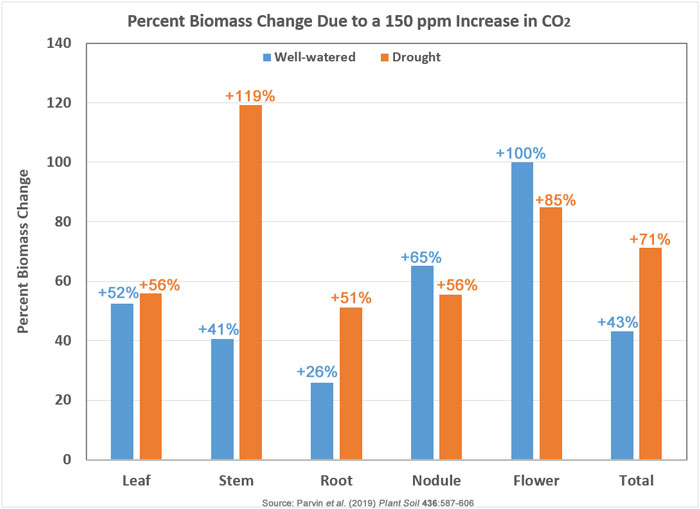Parvin, S., Uddin, S.,
Fitzgerald, G.J.,
Tausz-Posch, S.,
Armstrong, R. and
Tausz, M.
2019
Free air CO2 enrichment (FACE)
improves water use efficiency
and moderates drought effect
on N2 fixation of Pisum sativum L.
Plant Soil 436: 587-606.
NOTE:
Legumes include
key agricultural crops
'that contribute substantially
to both human and animal diets.
Parvin et al. (2019)
examined the growth response
of field pea (Pisum Sativum cv.
PBA Twilight) to elevated CO2
under two watering regimes.
SUMMARY:
The researchers
conclude that:
"growth under elevated CO2 can mitigate drought effects on N2 fixation and reduce dependency on soil N resources especially in water-limited agro-ecosystems."
From the
conclusion
section of
their paper:
"Results showed that elevated CO2 decreased stomatal conductance to a greater extent under drought and increased water use efficiency compared to ambient CO2.
As a consequence, the rate of soil water use was slowed sufficiently under elevated CO2 to enable the maintenance of photosynthesis and nodule activity longer during this drought period.
Lower amino acid concentration in nodules under elevated CO2 grown plants potentially avoided N2-feedback inhibition and maintained N2 fixation, thereby reducing dependency on soil N uptake.
Consistent with other studies, field pea grown under rising CO2 counteracted the negative effect of terminal drought on N2 fixation and improved N acquisition through incorporating a greater portion of biologically fixed N2 to plant biomass.
Presumably, the increase of biomass growth (also related to increased nodulation, N2 fixation) and soil water savings through reduced stomatal conductance under elevated CO2 during early growth is likely to enhance drought tolerance during reproductive stage."
DETAILS:
The experiment was conducted
at the Australian Grains
Free-air CO2 Enrichment
facility in Horsham, Victoria,
Australia.
The plants were grown
under ambient (400 ppm)
or elevated (550 ppm)
CO2 concentrations.
The elevated CO2
was applied during
daylight hours only,
and under well-watered
(field capacity
maintained at 80%)
And also terminal
drought conditions
(well-watered conditions
until the final month of the
experiment when water
was withheld to a
field capacity of 41%).
Following are quotes
from the paper:
1. "Field pea grown under elevated CO2 had greater net CO2 assimilation rate than under ambient CO2 and this trend was maintained throughout the drought period for both well-watered and drought treated plants."
2. "Elevated CO2 significantly increased biomass of all organs resulting in greater total biomass production compared to ambient CO2." See Figure 1, which shows increased from 26% to 100% under well-watered conditions to 51% to 119% under terminal drought conditions.
3, "Plants grown under elevated CO2 produced 33% more [root] nodules than under ambient CO2. Elevated CO2 increased specific nodule activity by 35% under drought compared to only 10% under well-watered condition."
4. "Greater net CO2 assimilation rate and lower stomatal conductance resulted in increased intrinsic water use efficiency under elevated CO2 and at later stages this increase was more prominent under drought (37% vs 56%)."
5. "Water use efficiency of biomass production (g biomass produced kg-1 water use) increased under drought with a proportionally greater response observed under elevated CO2 than ambient CO2 (50% vs 100%)." Increased intrinsic water use efficiency under elevated CO2 "was not offset by greater leaf area and resulted in slower soil water depletion under drought."
6. "Elevated CO2 had no effect on tissue nitrogen concentration except that flower nitrogen concentration increased by approximately 7% under drought, whereby it decreased in ambient CO2 grown drought treated plants."
7. "Total nitrogen content (mg N plant-1) of all plant organs and total plant nitrogen content were significantly greater under elevated CO2 due to greater biomass production."
8. "The total nitrogen budget for field pea indicated significantly greater amounts of fixed nitrogen under elevated CO2 in both aboveground and belowground plant nitrogen organs, irrespective of water treatments."
9. "Under ambient CO2 soil nitrogen contributed approximately 40% of the total plant nitrogen while under elevated CO2 this contribution was 20% for both well-watered and drought treated plants. The amount of nitrogen derived from the atmosphere was significantly greater under elevated CO2 compared to ambient CO2, irrespective of water treatment." "Total nitrogen [N2] fixation was 51% greater in elevated CO2 than ambient CO2 grown field pea when averaged across water regimes."
10. "Although drought reduced overall N2 fixation regardless of CO2 exposure, drought treated plants grown under elevated CO2 still recorded greater amounts of fixed N2 than well-watered plants under ambient CO2."
For the chart below:
Percentage change in
various biomass
arameters of field pea
(Pisum sativum)
under well-watered or
terminal drought conditions
(drought experienced
during the final four weeks
of the growing season)
in response to a 150 ppm
increase in atmospheric CO2.
